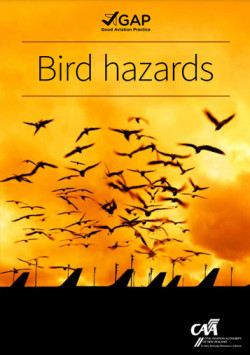A group dedicated to preventing bird strikes is having long-term success, without always resorting to culling.
Just about anything could happen when an aircraft is struck by a bird, says the New Zealand Aviation Wildlife1 Hazard Group, NZAWHG.
“It depends on the pilot’s reactions, what kind of bird, and where the bird hits the aircraft,” says Lizzie Civil, who’s the group’s chair.
A strike to the nose cone will be financially costly but not fatal. If birds are ingested into both engines, it could be a different story, Lizzie says.
New Zealand is doing fairly well with bird avoidance. Its bird strike rate at airports is about four in 10,000 aircraft movements.
“Of course, that strike rate could be four sparrows. That’s likely not going to cause much damage to a plane.
“Whereas a Canada goose could be catastrophic,” she says.
Part of the country’s success in avoiding bird strike is down to the work of the NZAWHG.
Annually, nearly every airport meets the NZAWHG to discuss how to reduce the risks of aircraft-versus-bird.
“We had a falconer at our last meeting. He discussed the pros and cons of using falcons for wildlife harassment at airports.
“Falconry is an environmentally friendly, cost-effective, and non-lethal way to deal with pest control.
“But it does require a well-trained and mature bird as well as an experienced handler.
“Further, the CAA has not yet approved the use of either a real or ‘robo’ falcon.
“However, it’s likely to just be a matter of time before falconry is used,” says Lizzie.
“It has great potential.”
A proactive rather than reactive approach
Lizzie – the former Wildlife and Ground Manager at Auckland Airport, and was an Airfield Environmental Officer at NZDF Whenuapai – says that, in the past, the approach to birdlife at airports was very much reactive culling.
“But culling some territorial airport wildlife that are, at least, used to that environment, and act in predictable ways, just leads to non-airport savvy wildlife coming in and acting erratically, and causing an even higher risk to aircraft.
“But we’ve managed to change the mindset of many aerodrome owners and operators, to a more ‘proactive’ one, that preserves the environment, while managing problematic species.
“What we do is manage the airport ecosystem, so it’s less attractive to whatever species may be a high risk to aviation.”
Often that includes building alternative habitats for the birds elsewhere, like bird roosts. And making sure any development near the airport doesn’t include bird-attracting features like flat roofs, and seeding, fruiting, or large roosting trees.
Lizzie says that in some cases, culls are necessary if the birds are categorised as high risk and their numbers are increasing.
“Spur-winged plovers for instance, often flock. They’re territorial, aggressive and are common to most New Zealand airports. They have the highest species strike rate and are often culled.
“But a holistic approach is getting better long-term results than just shooting the birds, and makes management steadier and easier to predict.”
Predicting a strike
To help aerodromes manage their bird strike risk, the NZAWHG has also designed a risk assessment model based on the likelihood of a bird strike at any particular aerodrome, and the consequences of such a strike.
“We assess the consequences of a strike by a particular species of bird. We do this by factoring in its weight and flocking characteristics – whether it flies solo or in groups – and its behaviour, so whether it’s a rapid or direct flier, or a hoverer, which is higher risk. Then we come up with a risk score.”
Birds of primary concern are large in size, flocking birds that are slow flying, less manoeuvrable or erratic, such as plovers, Canada geese and black swans. Secondary concerns are species of small to medium size that habitually hunt or forage on or over the airfield, like hawks, starlings, gull species, and waterfowl species. Or birds such as wading species, which habitually fly across the airspace.
“All the aerodromes then have to do is calculate the likelihood of a particular species of bird causing a strike at their airfield. Some base this on the presence of a particular species at their location. Other aerodromes calculate it on the basis of whether that bird has actually caused a strike in the previous five years. Some aerodromes use a combination.
“Airports then use these risk assessments to prioritise how they’ll manage wildlife hazards.
“A lot goes on behind the scenes for people to fly safely in and out of our airports.”
More reading
Check out our Good Aviation Practice (GAP) booklet on bird strikes.
GAP Booklet: Bird hazards [PDF 774 KB]
From Letters to Vector
Landing lights to avoid bird strikes
The latest Vector magazine (Winter, 2023) contained a letter regarding the use of landing lights to avoid bird strikes. I believe the writer has a valid point.
I spent 38 years flying for the airlines and retired from a major foreign airline five years ago. Our SOPs required us to use taxi lights, if required, until takeoff clearance was received, then landing lights were required to be switched on, and left on, until passing 10,000’/F100.
On descent, landing lights were again required from F100/10,000’ until clear of the runway. We had very few bird strikes.
In the five years since retiring, I’ve flown my own VFR aircraft around New Zealand, and still always operate with the landing lights on – partly to assist with being seen by others, but also to reduce the risk of a bird strike.
So far, no bird strikes.
Paul Jones
Blenheim
Footnote
While the group is called ‘wildlife’, the vast majority of strikes are by birds, although some aircraft in NZ have collided with the occasional rabbit.

